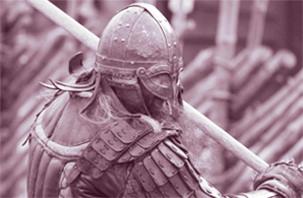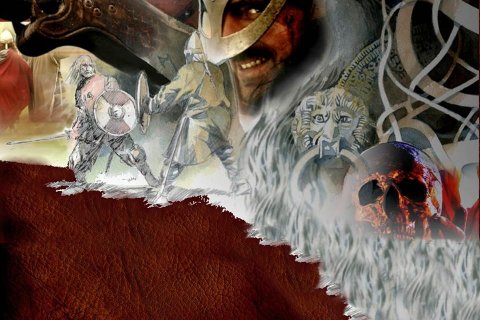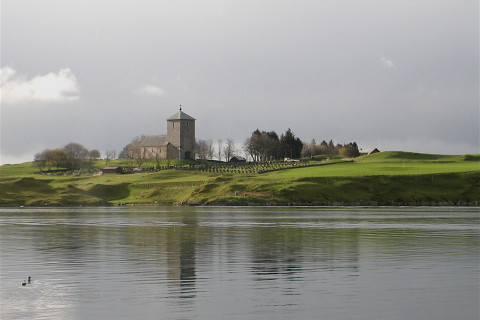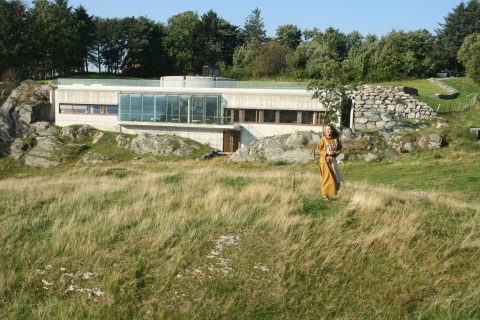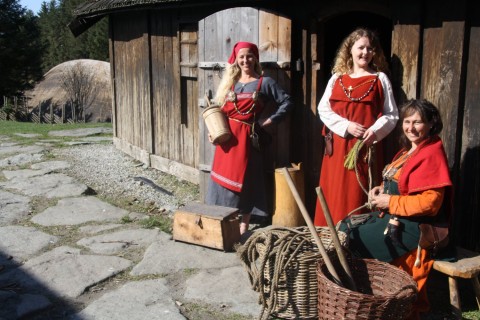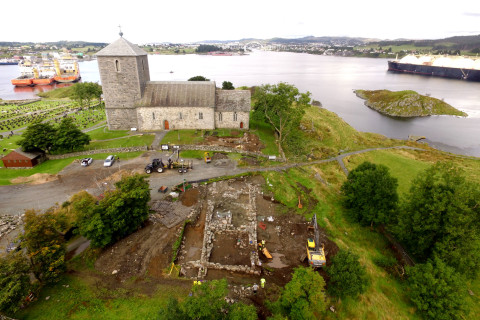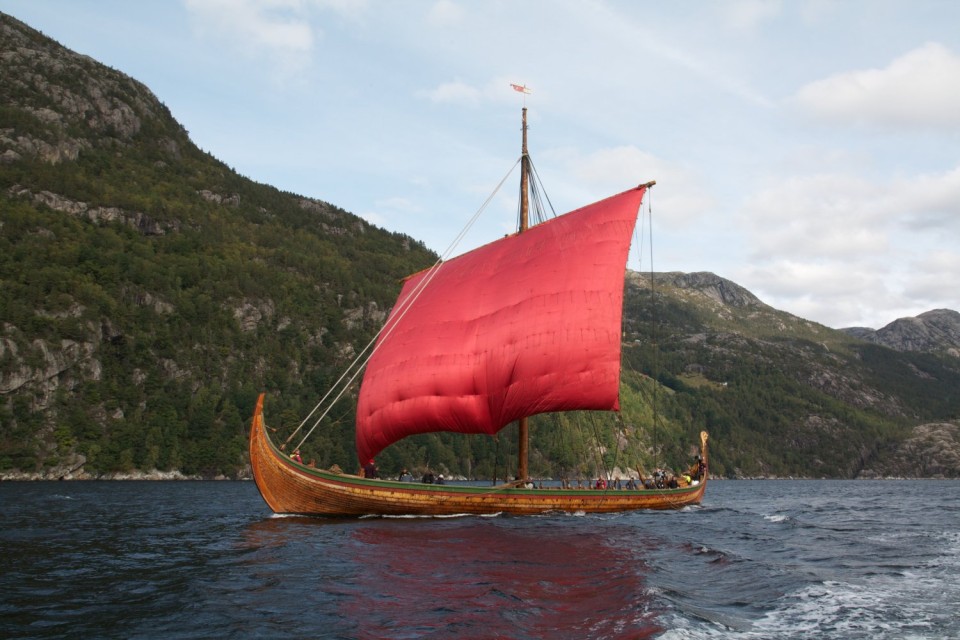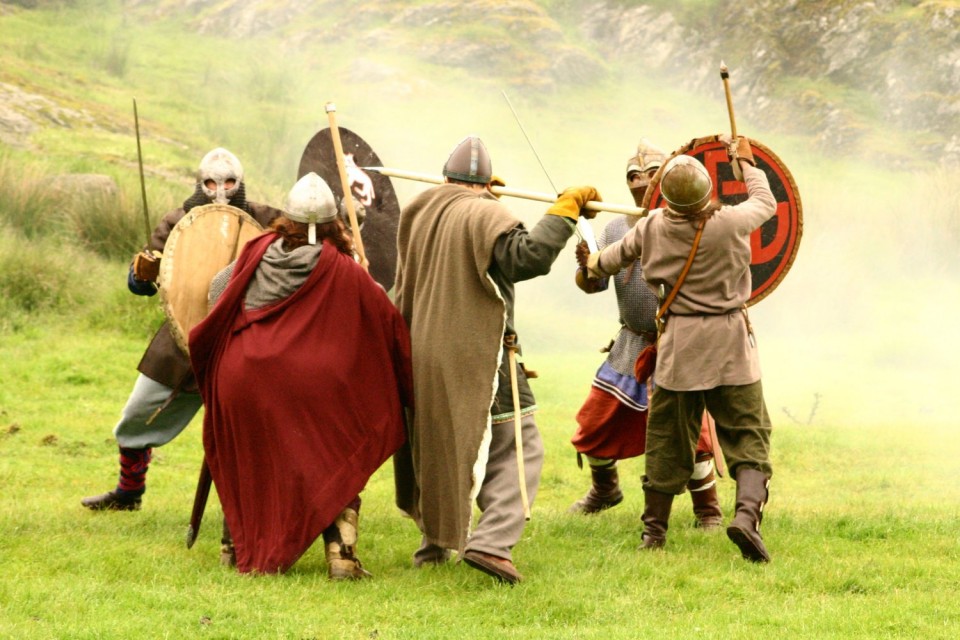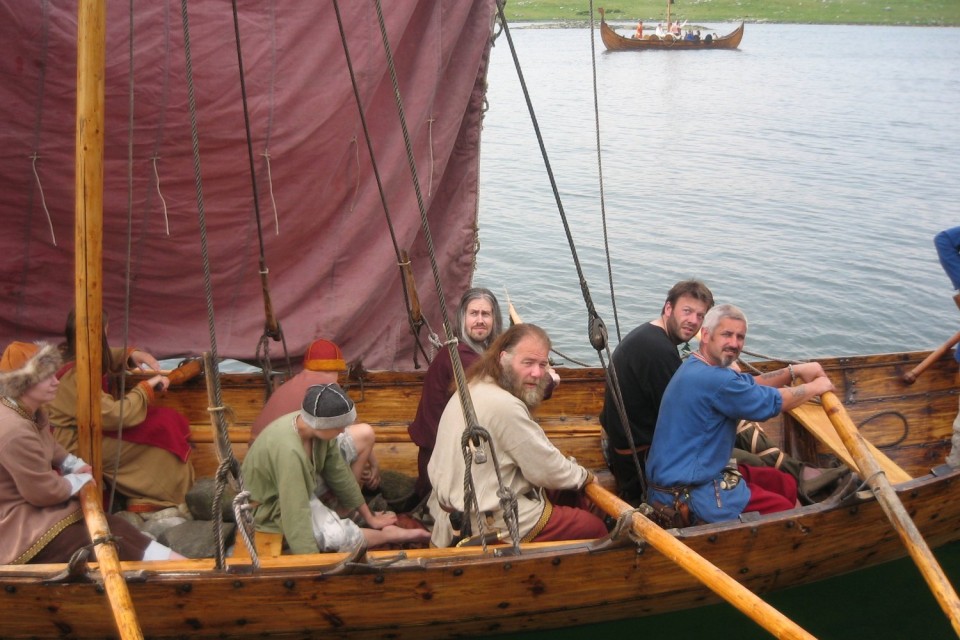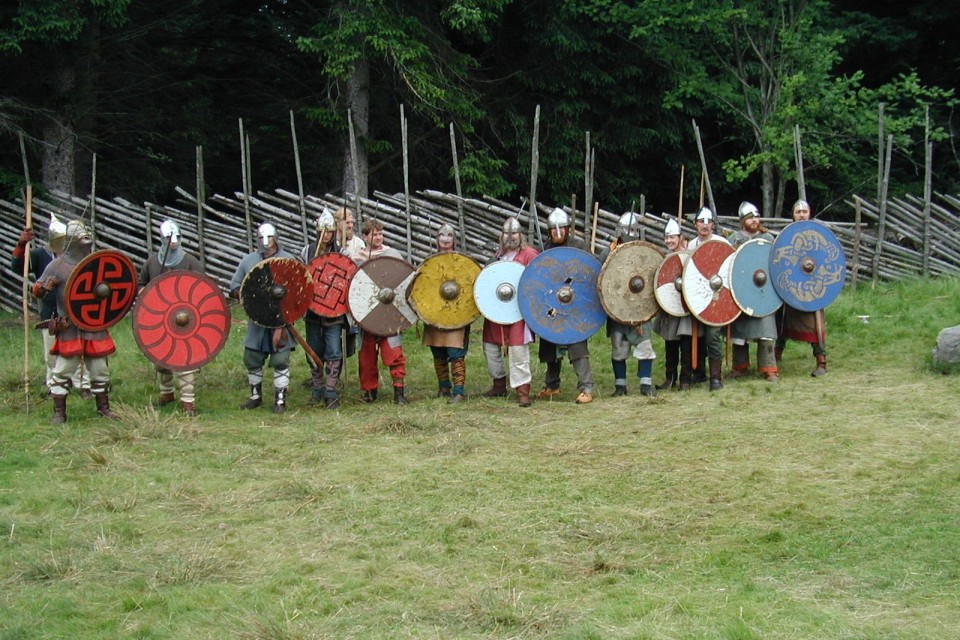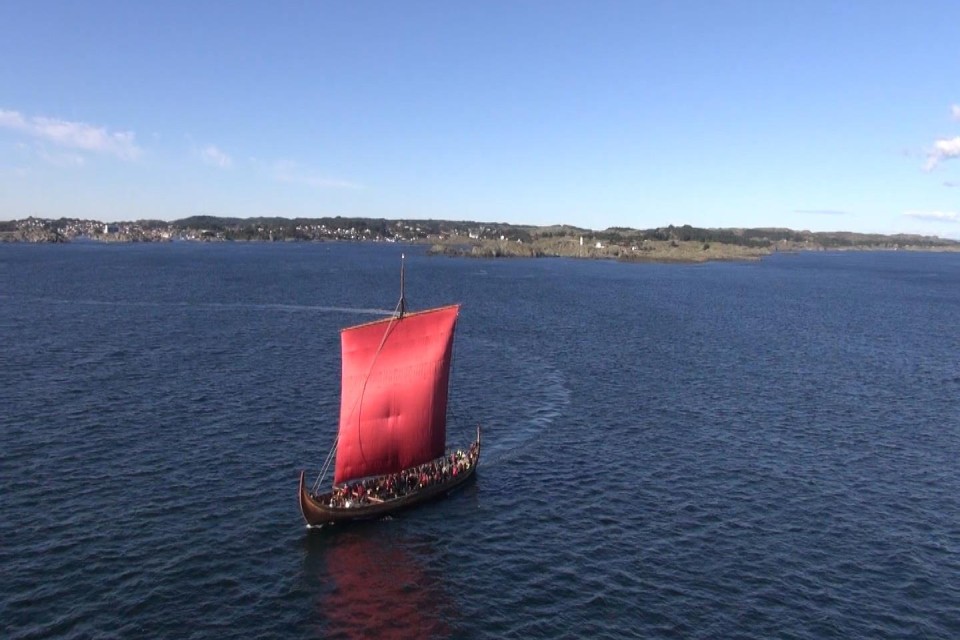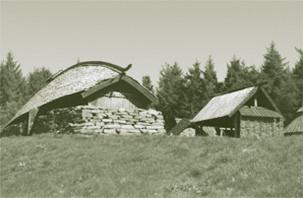Vikings
Tekst: Marit Synnøve Vea
THE VIKING AGE
The Viking Age was the years between 750 – 1100 when people from Norway, Sweden and Denmark made a name for themselves and became a political force to be reckoned with throughout Europe. From their travels in Europe, they adopted new ideas, cultural impulses and a new religion – Christianity.
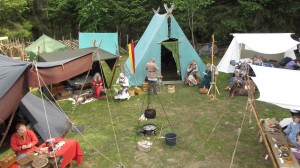
The Vikings were more than pirates and warriors. They were also sailors, merchants, craftsmen, farmers, fishermen, poets, explorers and nation-builders. (Photo Ørjan Iversen)
THE VIKINGS; SAILORS AND EXPLORERS
The Vikings are best known as pirates and warriors, but they were also sailors, merchants, craftsmen, farmers, fishermen, poets, explorers and nation-builders. The Scandinavian national states were founded during the Viking Age. And it is now the Northerners develop a vessel that better organized and wealthier societies on the Continent don’t have; The Viking ship.
It was the seaworthiness of the Viking ships, together with the sailors’ knowledge of navigation and seamanship, which made it possible for them to conquer the ocean. An Arabian source tells that: “The Vikings have filled the sea with red birds [sails] and our hearts with fear”.
Traditionally two historical events mark the beginning and the end of the Viking era:
- 793: The raid on Lindisfarne Monastery
- 1066: The battle at Stamford Bridge
When we look at the archaeological material, it will be more correct to say that the Viking Age started around 750. Some scientists also go further back in time and point out the first centuries after 700 as the time when the Viking Age started. It is now also customary to set the end of the Viking Age to ca. 1100.

Lindisfarne Castle. (Photo Wikimedia Commons).
“THE FURY OF THE NORSEMEN”
The Vikings have a reputation for brutality, but they lived in a brutal time, and were in fact no better and no worse than other people.
Archaeological evidence shows that people in Scandinavia had close contact with other people and countries long before the time period we now call Viking Age. Often the contact occurred in the form of peaceful trade missions, other times it was probably pure bargain expeditions.
Nevertheless, something must have happened in the 700s. It looks like the Scandinavian raids increase. In any case, it appears that the fear of the Vikings is increasing among other peoples. This may be due to the development of the Viking ship. The Vikings could come unexpectedly from the sea, attack suddenly and then disappear again. And unexpected attacks often create the greatest fear.
It was often monasteries that were attacked, and it is mainly Christian, literate monks who tell the story about the Viking attacks.
By the start of the Viking Age, Christianity has spread in Europe, but the Vikings were still pagans. It seems as if monks saw the Vikings, not only as marauding pirates, but also as a punishment from God. Therefore, the “raiding of heathen men” have seemed extra terrifying for the clergy.
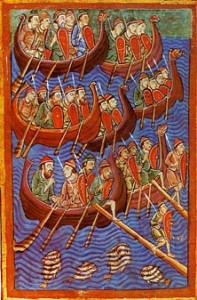
A Danish fleet invading England. Illuminated illustration from the 12th century. “Miscellany on the Life of St. Edmund.”
The Anglo-Saxon Chronicle of the year 793:
“Here terrible portents were come over the Northumbrian land, which miserably frightened the people, there were huge flashes of lightening, and fiery dragons were seen flying in the air. Much hunger soon followed these signs, and a little after that in the same year, on January 8, the raiding of heathen men miserably destroyed God’s church on Lindisfarne Island by looting and the killing of men.”
The Viking attack on Lindisfarne monastery must have made a strong impression on the Christian world, but we have many accounts of violence, even against Christian monks, before the Vikings made their entry.
Lindisfarne monastery was founded in 635 by the Irish monk Aidan while the Christian Oswald, was king of Northumbria. The monk Bede writes in his “Historia Ecclesiastic gentis Anglorum” from about 730 that Oswald’s father, Aethelfrith, was known as a crude and cruel king. He allegedly massacred 1200 Welsh monks while they prayed to God for victory in a battle. When Aethelfrith fell, his four children were sent as hostages to the monastery on Iona, where his son Oswald was trained in the Christian faith.
Written sources also tell us that the Frankish king Charles the Great who was a Christian, committed serious acts of violence. It is said that he in a single day in 782 beheaded 4500 children, women and men in the Saxon town of Verden. This as punishment for the Saxons rebellion against the Franks, and because the Saxons still held on to their pagan beliefs. However, there is no archaeological evidence that such beheadings have taken place.
Some also believe that Charles the Great’ s aggression in Europe is a possible reason for the resurgence of Viking raids.
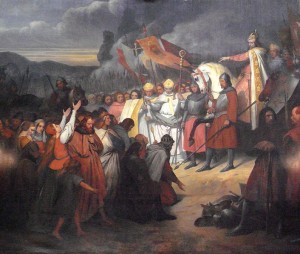
Charlemagne (742–814) receiving the submission of Widukind at Paderborn in 785. Widukind was a Germanic leader of the Saxons and the chief opponent of the Charlemagne. (By Ary Scheffer (1795–1858). Versailles.
THE VIKING HOMELANDS
Sverige/Sweden. Means: “The kingdom of the Svear”. (Svear: name of the inhabitants) + (rike: the territory where a king reigns)
Danmark/Denmark. Means: “The land of the Danes”: (Daner: name of the inhabitants) + (mark: borderland)
Noreg/Norway. Means: “The way north” (Norðvegr): (Norð: north ) + (vegr: the fairway along the coast)
WHAT DOES THE WORD VIKING MEAN?
Today, the word Viking is used about men, women and children who, in the years from 750 – 1100 AD, lived in Norway, Sweden and Denmark or in the areas where these Norsemen settled down.
The meaning of the Old Norse word vikingr was probably at first “Sea warrior who journeys far from home”; hence the phrase “to set out on a Viking raid”.
But: It was not only Scandinavians who “went viking”. Irishmen, Anglo-Saxons, Franks, Bretons and Slaves all joined in Viking raids at times.
Originally, the word “Viking” probably denoted “sea warrior”, but where did the actual word come from?
THE ORIGIN OF THE WORD VIKING – SEVERAL THEORIES

Map showing Viking homelands and places where they settled down. (Photo Wikimedia Commons)
Norse origin
From “vik” – bay/inlet/creek: “Men who hide in creeks”
From “Viken” (in the Oslo fiord): “Men from Viken” . Common, but still doubtful interpretation
because men from Viken were called “vestfaldingi” or “vikverjar” and old skaldic poems use the word Viking of men from western and northern Norway.
From “vig” (battle): “Men who fight”
From the verb “å vike” (to retreat): “Men who retreat with their booty”
From “wican” (sealer): “Men who catch seals”
From the verb “vikja” (to withdraw/evade): “Men who venture out from their home community”
Other origins
From the Anglo-Saxon “vic” (camp): The word existed in Anglo-Saxon before the Viking age (Wicinga Cynn from the 8th century = Viking people)
From the Latin “vicus” (town): Viking = “Town-dweller”
From “wics” (trading post): Viking = “People from the North who visited trading posts”

Varangian Guardsmen in Constantinople.
An illumination from the 11th century chronicle of John Skylitzes.
WHAT DID PEOPLE OUTSIDE SCANDINAVIA CALL THE VIKINGS?
The Vikings were called pagans or strangers in several languages. In addition to this, they were called by :
The French: Normanni/ Vikverjar
The Anglo-Saxons: Danes/Northmen
The Germans: Ascomanni (Adam of Bremen ca 1070: The pirates that the Danes call Vikings, but whom we call Ascomanni)
The Irish: Lochlannach: (White Lochlannach = Norwegians, believed to be after thecolour of their shields. (Black lochlannach = Danes)
Gall: “Foreigner” (Celtic/Ireland) as in “Galloway”. Finn-Gall: White Foreigner (Norwegians), Dubh-Gall= Black Foreigner (Danes)
The Arabs: Rus (Swedes – from “Ruotsi”, may come of “rowers”, or from the Finnish name for Sweden, deriving from the place name Roslagen).
The Greeks: Væringer or Varjager (meaning “merchants”).
The Spanish: Al-madjus (meaning “sorcerers” or “medicine men”)
THINGS THAT PEOPLE OUTSIDE SCANDINAVA SAID ABOUT THE VIKINGS.
About the “danger from the North”
Anglo-Saxon Chronicle about the year 789:
“In these days there came for the first time three ships of Northmen from Hørthaland.(…)That was the first time the ships of the Danes had sought the land of the English. “
The Anglo-Saxon Chronicle of the year 793:
“Here terrible portents were come over the Northumbrian land, which miserably frightened the people, there were huge flashes of lightening, and fiery dragons were seen flying in the air. Much hunger soon followed these signs, and a little after that in the same year, on January 8, the raiding of heathen men miserably destroyed God’s church on Lindisfarne Island by looting and the killing of men”
“Deliver us, o God, from the fury of the Norsemen.” – the prayer that was said in monasteries around Europe when Viking raids were at their worst.
On an Irish bible, the following poem has been scribbled in the margin:
“Bitter is the wind tonight
It tosses the ocean’s white hair
I do not fear the fierce warriors of Norway
Coursing on the Irish Sea tonight.”
Servatus Lupus, Carolingian Benedictine abbot; says “No journey is too long for the men from the North”.
An Arabian source relates: “The Vikings have filled the sea with red birds [sails] and our hearts with fear”.
More positive impressions of the Vikings:
Christian historians did also, albeit reluctantly, find something favourable to say about the Vikings.
An old, French source reveals the following about a Viking army from Denmark: “Never before had such tall and handsome heroes been seen in the kingdom of France”.
The Arab Ibn Fadlan says: “I have never seen more perfect physical specimens, tall as date palms, blonde and ruddy.”
English cleric John of Wallingford: “It is reported (..) that the Danes, thanks to their habit of combing their hair every day, of bathing every Saturday and regularly changing their clothes, were able to undermine the virtue of married women and even seduce the daughters of nobles to be their mistresses.”
Irish annals tell of the Norwegian Olav Kvite (Amhláib) who became king of Dublin. Olav Kvite took the Scottish king’s sister (Maelmuire) as his wife, but he didn’t care very much about her. But Olav’s brother Asle (Auisle) did. Asle therefore suggested that the Scottish princess should be his. Olav then killed his brother Asle and the latter was described by his enemies as “The most stately and courageous man in the world”.
The Vikings were also said to have a sense of justice
The Irish nobleman Findan was betrayed by his own followers and handed over to the Vikings who sold him as a slave. The fourth Viking chieftain he was sold to wanted to go home to his own country.
Findan was tied up and stowed into the ship. On the voyage home, they were attacked by another Viking ship and a battle ensued. Findan called out to his Viking master that he wanted to help in the fight. The battle abated, and the Viking chieftain did not forget that Findan had offered him his help. “He therefore freed Findan and declared that all should be reconciled between them”.
Back

